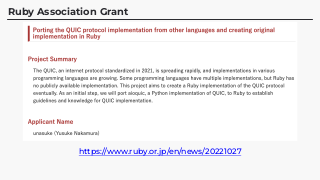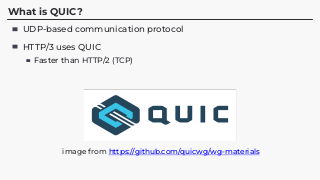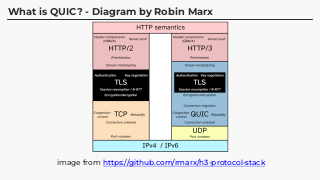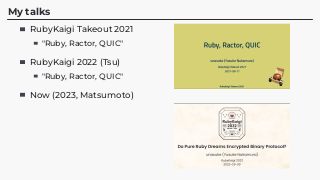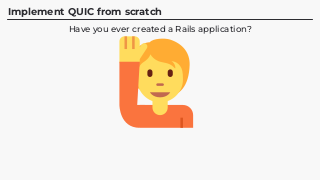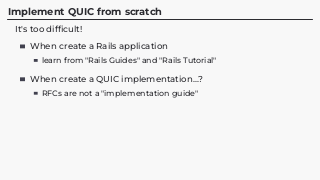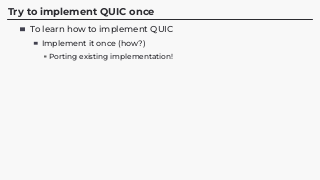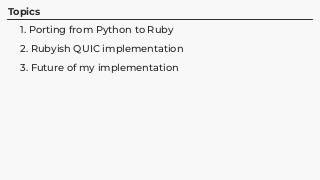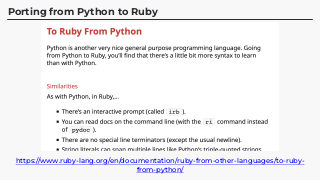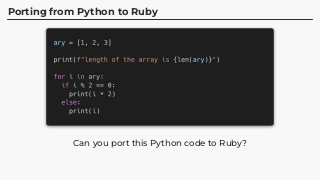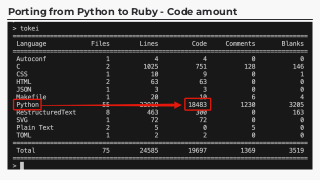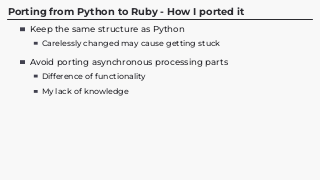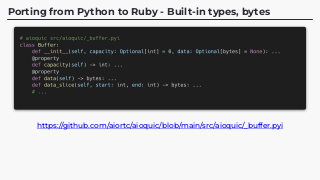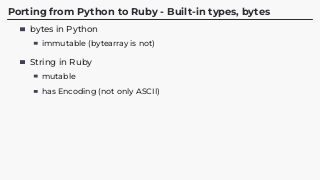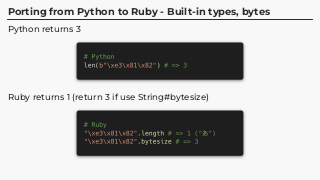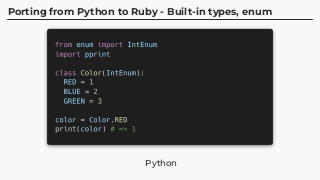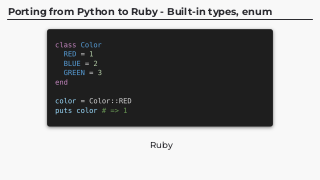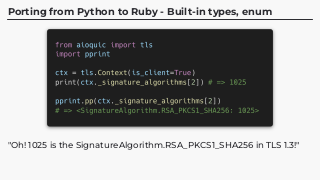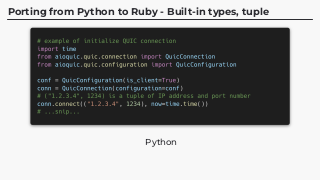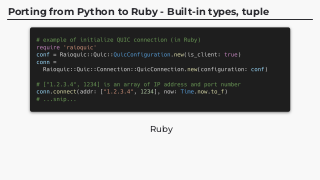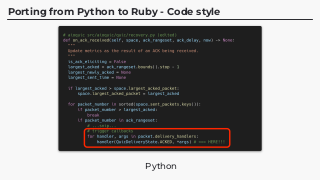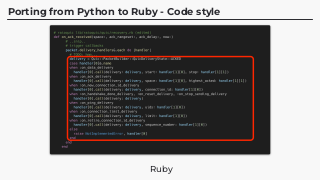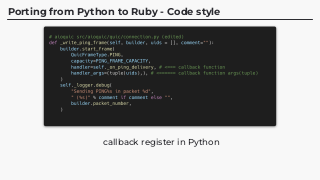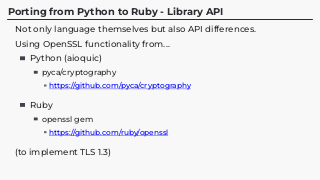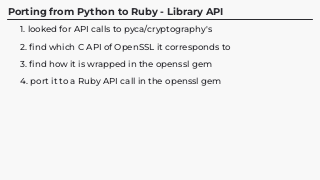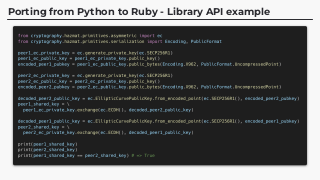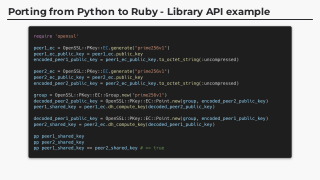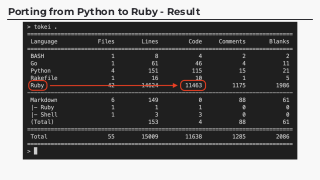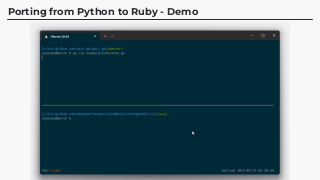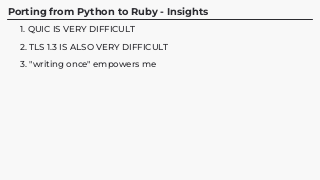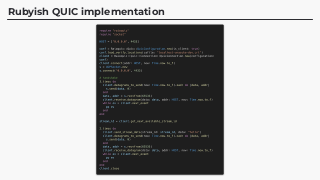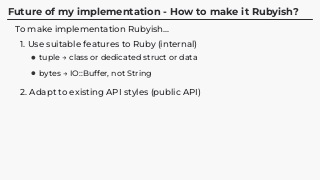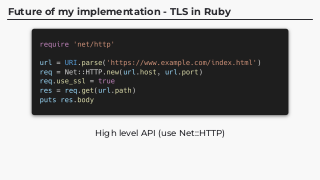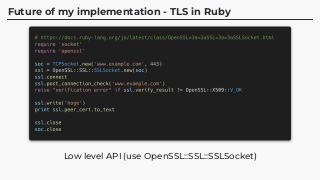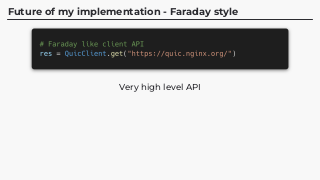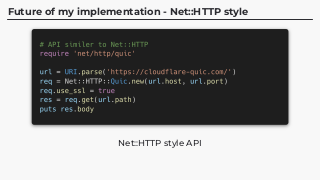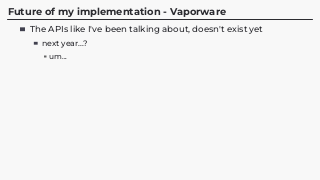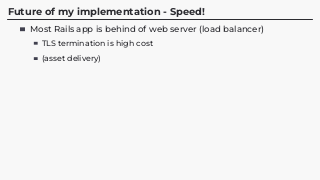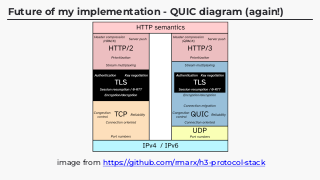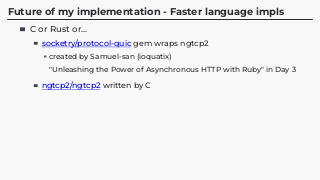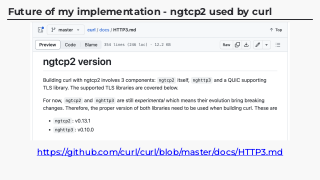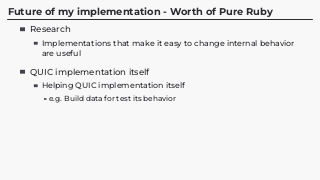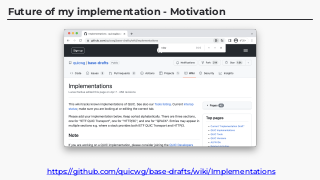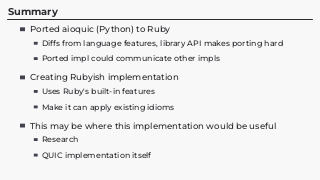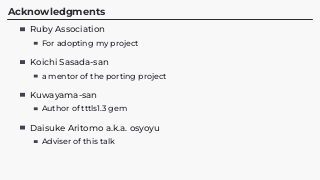Text
Page: 1
Ruby Implementation of QUIC: Progress and Challenges unasuke (Yusuke Nakamura) RubyKaigi 2023 2023-05-12
Page: 2
Self introduction Name: unasuke (Yusuke Nakamura) Work: freelance Web app developer @ Japan Itamae gem maintainer, Kaigi on Rails Organizer GitHub https://github.com/unasuke Mastodon https://mstdn.unasuke.com/@unasuke Twitter https://twitter.com/yu_suke1994
Page: 3
Ruby Association Grant https://www.ruby.or.jp/en/news/20221027
Page: 4
What is QUIC? UDP-based communication protocol HTTP/3 uses QUIC Faster than HTTP/2 (TCP) image from https://github.com/quicwg/wg-materials
Page: 5
What is QUIC? - Diagram by Robin Marx image from https://github.com/rmarx/h3-protocol-stack
Page: 6
My talks RubyKaigi Takeout 2021 "Ruby, Ractor, QUIC" RubyKaigi 2022 (Tsu) "Ruby, Ractor, QUIC" Now (2023, Matsumoto)
Page: 7
Implement QUIC from scratch Have you ever created a Rails application?
Page: 8
Implement QUIC from scratch Have you ever implemented the QUIC protocol?
Page: 9
Implement QUIC from scratch It's too difficult! When create a Rails application learn from "Rails Guides" and "Rails Tutorial" When create a QUIC implementation...? RFCs are not a "implementation guide"
Page: 10
Try to implement QUIC once To learn how to implement QUIC Implement it once (how?) Porting existing implementation!
Page: 11
Topics 1. Porting from Python to Ruby 2. Rubyish QUIC implementation 3. Future of my implementation
Page: 12
Porting from Python to Ruby https://www.ruby-lang.org/en/documentation/ruby-from-other-languages/to-ruby- from-python/
Page: 13
Porting from Python to Ruby Can you port this Python code to Ruby?
Page: 14
Porting from Python to Ruby - Code amount
Page: 15
Porting from Python to Ruby - How I ported it Keep the same structure as Python Carelessly changed may cause getting stuck Avoid porting asynchronous processing parts Difference of functionality My lack of knowledge
Page: 16
Porting from Python to Ruby - Built-in types, bytes https://github.com/aiortc/aioquic/blob/main/src/aioquic/_buffer.pyi
Page: 17
Porting from Python to Ruby - Built-in types, bytes bytes in Python immutable (bytearray is not) String in Ruby mutable has Encoding (not only ASCII)
Page: 18
Porting from Python to Ruby - Built-in types, bytes Python returns 3 Ruby returns 1 (return 3 if use String#bytesize)
Page: 19
Porting from Python to Ruby - Built-in types, enum Python
Page: 20
Porting from Python to Ruby - Built-in types, enum Ruby
Page: 21
Porting from Python to Ruby - Built-in types, enum "Oh! 1025 is the SignatureAlgorithm.RSA_PKCS1_SHA256 in TLS 1.3!"
Page: 22
Porting from Python to Ruby - Built-in types, tuple Python
Page: 23
Porting from Python to Ruby - Built-in types, tuple Ruby
Page: 24
Porting from Python to Ruby - Code style Python
Page: 25
Porting from Python to Ruby - Code style Ruby
Page: 26
Porting from Python to Ruby - Code style callback register in Python
Page: 27
Porting from Python to Ruby - Library API Not only language themselves but also API differences. Using OpenSSL functionality from... Python (aioquic) pyca/cryptography https://github.com/pyca/cryptography Ruby openssl gem https://github.com/ruby/openssl (to implement TLS 1.3)
Page: 28
Porting from Python to Ruby - Library API 1. looked for API calls to pyca/cryptography's 2. find which C API of OpenSSL it corresponds to 3. find how it is wrapped in the openssl gem 4. port it to a Ruby API call in the openssl gem
Page: 29
Porting from Python to Ruby - Library API example
Page: 30
Porting from Python to Ruby - Library API example
Page: 31
Porting from Python to Ruby - Result
Page: 32
Porting from Python to Ruby - Demo
Page: 33
Porting from Python to Ruby - Insights 1. QUIC IS VERY DIFFICULT 2. TLS 1.3 IS ALSO VERY DIFFICULT 3. "writing once" empowers me
Page: 34
Porting from Python to Ruby - "Raioquic" https://github.com/unasuke/raioquic
Page: 35
Rubyish QUIC implementation
Page: 36
Future of my implementation - How to make it Rubyish? To make implementation Rubyish... 1. Use suitable features to Ruby (internal) tuple → class or dedicated struct or data bytes → IO::Buffer, not String 2. Adapt to existing API styles (public API)
Page: 37
Future of my implementation - TLS in Ruby High level API (use Net::HTTP)
Page: 38
Future of my implementation - TLS in Ruby Low level API (use OpenSSL::SSL::SSLSocket)
Page: 39
Future of my implementation - Faraday style Very high level API
Page: 40
Future of my implementation - Net::HTTP style Net::HTTP style API
Page: 41
Future of my implementation - Vaporware The APIs like I've been talking about, doesn't exist yet next year...? um...
Page: 42
Future of my implementation - Raise your hand time! Are you running some Rails apps on production env?
Page: 43
Future of my implementation - Raise your hand time! Are you running some Rails apps on production without reverse proxies or load balancers?
Page: 44
Future of my implementation - Speed! Most Rails app is behind of web server (load balancer) TLS termination is high cost (asset delivery)
Page: 45
Future of my implementation - QUIC diagram (again!) image from https://github.com/rmarx/h3-protocol-stack
Page: 46
Future of my implementation - Faster language impls C or Rust or... socketry/protocol-quic gem wraps ngtcp2 created by Samuel-san (ioquatix) "Unleashing the Power of Asynchronous HTTP with Ruby" in Day 3 ngtcp2/ngtcp2 written by C
Page: 47
Future of my implementation - ngtcp2 used by curl https://github.com/curl/curl/blob/master/docs/HTTP3.md
Page: 48
Future of my implementation - Worth of Pure Ruby Research Implementations that make it easy to change internal behavior are useful QUIC implementation itself Helping QUIC implementation itself e.g. Build data for test its behavior
Page: 49
Future of my implementation - Motivation https://github.com/quicwg/base-drafts/wiki/Implementations
Page: 50
Summary Ported aioquic (Python) to Ruby Diffs from language features, library API makes porting hard Ported impl could communicate other impls Creating Rubyish implementation Uses Ruby's built-in features Make it can apply existing idioms This may be where this implementation would be useful Research QUIC implementation itself
Page: 51
Acknowledgments Ruby Association For adopting my project Koichi Sasada-san a mentor of the porting project Kuwayama-san Author of tttls1.3 gem Daisuke Aritomo a.k.a. osyoyu Adviser of this talk






















































